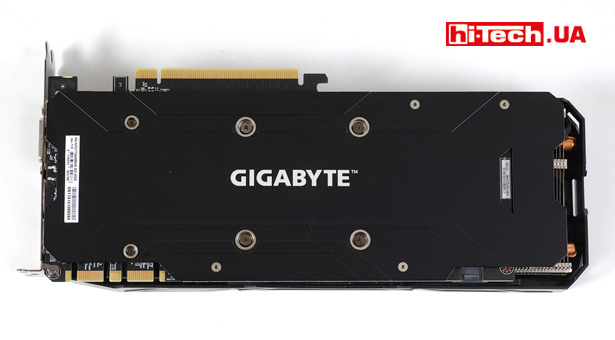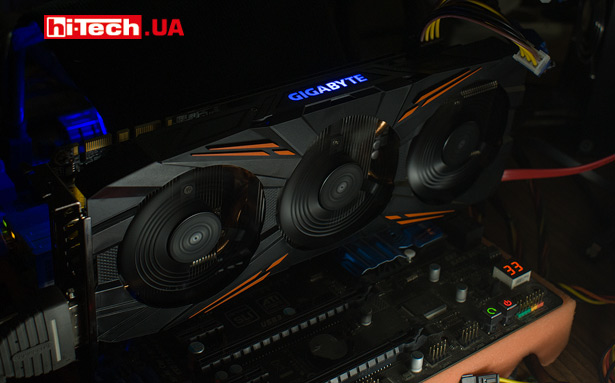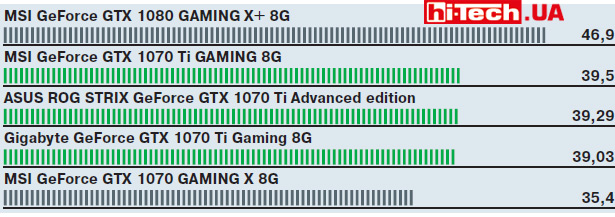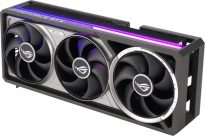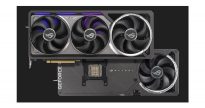NVIDIA GeForce GTX 1070 Ti by ASUS, Gigabyte and MSI videocards review. Filling niches
15.12.17
GTX 1070 Ti video cards were recently introduced. They occupied a niche between the GTX 1070 and GTX 1080. We figure out why NVIDIA needed another model based on the Pascal architecture and consider several new products based on the GTX 1070 Ti from different manufacturers
See this article:
- Comparison of reference characteristics of NVIDIA GeForce GTX 1070, 1070 Ti and 1080 video cards
- Summary table of characteristics of video cards based on NVIDIA GeForce GTX 1070 Ti presented in the test
- Gigabyte GeForce GTX 1070 Ti Gaming 8G graphics card
- MSI GeForce GTX 1070 Ti GAMING 8G graphics card
- ASUS ROG STRIX GeForce GTX 1070 Ti Advanced edition video card
- Description of the test bench and testing methodology
- Histograms with test results
In the GTX 10XX series of video cards, NVIDIA’s line of models from medium to high class was built quite evenly. There are clear steps in performance between the GTX 1060, 1070, 1080, and 1080 Ti.
But recently NVIDIA presented another model – the GTX 1070 Ti. It is built on the same NVIDIA Pascal architecture as other GTX 10XX series adapters, and takes its place between the GTX 1070 and GTX 1080.
It is curious that a year and a half has passed since the appearance of the first video card based on Pascal architecture (GTX 1080) and the appearance of the GTX 1070 Ti.
There is nothing fundamentally new in the GTX 1070 Ti. In terms of feature set and technology support, it has the same features as other models in this series.
If you compare the NVIDIA GeForce GTX 1070 Ti with the GTX 1070 and GTX 1080, you will notice that in terms of the characteristics of the graphics processor (number of shader processors, texture units) the new product is closer to the GTX 1080, but the type of memory and memory frequency are the same as the GTX 1070. The GTX 1070 Ti and GTX 1070 use GDDR5 memory, while the GTX 1080 comes with the more advanced GDDR5X.
Why did NVIDIA need another GTX 10XX series video card?
One of the possible reasons for the appearance of the GeForce GTX 1070 Ti can be called increased competition in the high-performance video card sector due to the emergence of new AMD Radeon RX Vega 56 and RX Vega 64 adapters from the competitor.
Perhaps NVIDIA decided to insure itself a little in this way.
Let’s also not forget about the continued high demand for powerful graphics cards associated with cryptocurrency mining.
There is another factor, but it is based only on rumors and guesses. GDDR5X video memory, which is used in the GTX 1080, is more scarce and more expensive compared to “regular” GDDR5. Accordingly, the GTX 1070 Ti is a good backup option.
Everyone is equal, as if by selection
When testing video cards based on NVIDIA GeForce GTX 1070 Ti (despite the fact that we had completely non-reference models with advanced proprietary cooling systems and upgraded boards), we noticed that the operating frequencies of most participants corresponded to standards.
This situation has not been observed for quite some time and we have even gotten used to the fact that manufacturers traditionally increase frequencies to one degree or another.
In this case it is no coincidence. In models based on the GTX 1070 Ti, NVIDIA obliged video card manufacturers to maintain reference frequencies.

This is likely due to the fact that by using a relatively small overclock on the GTX 1070 Ti, they will be too close in performance to the GTX 1080 and could create unnecessary internal competition.
But manufacturers still have some tools with which they can influence frequencies.
Firstly, the actual Boost frequency of the NVIDIA GPU very often exceeds the specified frequency for the Boost mode. In what modes and by how much this excess will be depends on the video card manufacturers. In the table, we separately indicated the recorded maximum GPU frequency values of the tested video cards.
Secondly, by installing a proprietary application, you can literally in one click switch the video card to the mode provided by the manufacturer with some overclocking.
GTX 1070 Ti and mining
The topic of cryptocurrency mining using video cards is still very relevant. The GTX 1070 Ti graphics cards are great for this.
They allow you to control overclocking and power consumption within a fairly wide range, and you can fine-tune the settings for a particular algorithm.
For most mining algorithms, as in gaming applications, you can expect the GTX 1070 Ti to have performance levels between the GTX 1070 and GTX 1080. The exception is Ethash, which is used to mine Ethereum (ETH) coins, for example. This is where the GTX 1070 Ti can outperform the GTX 1080 because the Ethash algorithm is better suited to GDDR5 memory rather than GDDR5X.
We paid special attention to the manufacturer of the memory chips of the tested video cards. The ASUS ROG STRIX GeForce GTX 1070 Ti Advanced edition, Gigabyte GeForce GTX 1070 Ti Gaming 8G, and MSI GeForce GTX 1070 Ti GAMING 8G video cards in question turned out to have memory manufactured by Micron.
Test participants


ASUS ROG STRIX GeForce GTX 1070 Ti Advanced edition, Gigabyte GeForce GTX 1070 Ti Gaming 8G, MSI GeForce GTX 1070 Ti GAMING 8G
We managed to assemble three GTX 1070 video cards for review: ASUS ROG STRIX GeForce GTX 1070 Ti Advanced edition, Gigabyte GeForce GTX 1070 Ti Gaming 8G, and MSI GeForce GTX 1070 Ti GAMING 8G. All models have modified boards compared to the reference one and are equipped with proprietary cooling systems.
Comparison table of characteristics
Gigabyte GeForce GTX 1070 Ti Gaming 8G (GV-N107TGAMING OC-8GD)

Gigabyte GeForce GTX 1070 Ti Gaming 8G
The Gigabyte GeForce GTX 1070 Ti Gaming 8G board cannot be called small at all, but when all three test participants are put together, it is clearly noticeable that this model turned out to be the most compact among them.
The video card received an upgraded board compared to the reference one and a proprietary cooling system with a series of heat pipes and three fans.

The fans stop if the GPU temperature drops below 46 °C, and start if the temperature rises above 59 °C

The board will occupy no more than three expansion slots in the system

One eight-pin connector is provided to power the video card. The connector key is prudently turned outward
The use of eight power phases (6+2 configuration) is noted, compared to six phases (5+1) in the reference GeForce GTX 1070 Ti. The manufacturer emphasizes that the heatsink touches not only the GPU, but also the video memory chips through thermally conductive pads.
The maximum temperature of the Gigabyte GeForce GTX 1070 Ti Gaming 8G GPU under load in our conditions was 67 °C. This is a very comfortable level.

Monitoring the performance of Gigabyte GeForce GTX 1070 Ti Gaming 8G in the MSI Afterburner application
The fan rotation speed was about 1700–1800 rpm. The video card operates quietly, and while running in the case you are unlikely to notice the noise of this video card compared to the other components. But among other test participants this is the highest value.
Apparently, this is due to the fact that it does not have such a massive radiator and requires slightly higher fan speeds.
Despite the fact that NVIDIA obliged manufacturers to leave reference frequencies for solutions based on the GTX 1070 Ti, in the Gigabyte GeForce GTX 1070 Ti Gaming 8G, presented in the test, the frequencies still turned out to be slightly increased. Instead of standard 1607/1683 MHz for the base and Boost frequencies, respectively, frequencies of 1620/1709 MHz are provided here.

And in the screenshot on the right you can see how the GPU frequency settings of the Gigabyte GeForce GTX 1070 Ti Gaming 8G (GV-N107TGAMING OC-8GD) video card change when you select a preset overclocking mode in a proprietary application compared to the factory settings (on the left). Data from GPU-Z
How this happened – one can only guess. Perhaps Gigabyte prepared this video card before the restrictions were introduced and did not redesign it.
This increase, combined with the highest GPU Boost frequency we recorded among other GTX 1070 Ti-based competitors, allowed the Gigabyte GeForce GTX 1070 Ti Gaming 8G to stand out slightly among its competitors in terms of performance.
Note that it is the Gigabyte GeForce GTX 1070 Ti Gaming 8G with the index GV-N107TGAMING OC-8GD that has higher frequencies (note the presence of OC in the index). The GV-N107TGAMING-8GD version operates at reference frequencies. By the way, you will not find the GV-N107TGAMING OC-8GD modification on the official website (the situation at the time of preparation of the material). The manufacturer does not want to “shine” the GTX 1070 Ti model with increased frequencies?

The only backlit areas on the Gigabyte GeForce GTX 1070 Ti Gaming 8G graphics card are the Gigabyte and Fan Stop inscriptions on the side panel. Lighting effects and backlight color can be customized. At the same time, Fan Stop also serves as a sensor. The inscription lights up when the fans stop
The proprietary software allows you to select preset operating profiles for the board, including overclocked mode. Various overclocking settings (frequencies, power consumption, voltage, etc.) and monitoring tools are available. Not without
backlight control options. In general, a fairly standard set that can be seen in software for modern video cards from different manufacturers.
Gigabyte GeForce GTX 1070 Ti Gaming 8G (GV-N107TGAMING OC-8GD) rating:
+ the most compact compared to other test participants
+ increased frequencies
+ fans switch off at low load
- fan rotation speed is slightly higher than that of competitors
MSI GeForce GTX 1070 Ti GAMING 8G

MSI GeForce GTX 1070 Ti GAMING 8G
The design and features of the MSI GeForce GTX 1070 Ti GAMING 8G are typical of the proprietary MSI GAMING GTX 10 series of video cards.
This is not the first time we have encountered devices in this series, and we have already noted the excellent preparation of these products more than once.

Fans stop if the GPU temperature drops below 50 °C and start if the temperature rises above 62 °C

The MSI GeForce GTX 1070 Ti GAMING 8G board has been significantly changed compared to the reference one. It uses a 10-phase (8+2 circuit) power system, which also provides for the presence of not one eight-pin, but a bunch of two (8-pin+6-pin) power connectors. This solution is used only here among other video cards in the review.

Only this model has two connectors for additional power supply for review participants based on the GTX 1070 Ti.
It looks like the board was borrowed for the MSI GeForce GTX 1070 Ti GAMING 8G from the older GTX 1080.
The used radiator of the proprietary cooling system is quite large, but it does not extend beyond two slots.
Video memory chips are covered with a separate plate.

The MSI GeForce GTX 1070 Ti GAMING 8G video card is large in height, but the manufacturer kept the width within two slots
The video card’s CO demonstrated simply excellent efficiency. Under load, the GPU temperature remained at a low level (65 ° C) and the fan rotation speed was very low (about 1000 rpm).
The video card has a significant thermal reserve for experiments with overclocking, but the maximum Boost frequency when working without overclocking turned out to be the most modest among the test participants.

Frequency and voltage curve of the MSI GeForce GTX 1070 Ti GAMING 8G GPU, as provided by the manufacturer
The lighting system includes red “claws” on one of the fans and a corporate logo on the side panel.
Various glow effects can be applied to both the claws and the logo, but color selection is limited to the logo. “Claws” glow only red.


Luminous elements of MSI GeForce GTX 1070 Ti GAMING 8G
Backlight control, profile selection, display of various diagnostic data on top of the image (FPS, GPU temperature, memory load, etc.) and many other features can be found in the proprietary MSI Gaming App.
But in our case, this application did not start (we used the latest version from the official website). Probably, the video card is still too new and the manufacturer has not yet managed to add its support in this application.
The published screenshots of the proprietary application were taken using another MSI GAMING series video card and are provided for informational purposes only.
Separate software can synchronize the backlight of the video card with other compatible components, for example, the motherboard.
We also note that the proprietary MSI Afterburner application, which once upon a time was called RivaTuner, today is almost the best software for overclocking and monitoring the parameters of video cards, and not only MSI video cards, but also
any others.
MSI GeForce GTX 1070 Ti GAMING 8G Rating:
+ powerful board with 10-phase power supply
+ very quiet cooling system
+ fans switch off at low load
- the most modest Boost frequency among all participants
ASUS ROG STRIX GeForce GTX 1070 Ti Advanced edition (ROG-STRIX-GTX1070TI-A8G-GAMING)

ASUS ROG STRIX GeForce GTX 1070 Ti Advanced edition
The video card belongs to the ROG series of gaming products. And from experience we can say that this automatically means the presence of a set of interesting advanced features.
The board turned out to be the largest in the test, both in length and width. It will occupy three expansion slots in the system.

Unlike other GTX 1070 Ti video cards, this model has not one, but two HDMI ports. This may be important when using some VR systems, when you use one of the HDMI connectors to connect a monitor or TV


Service LEDs are located next to the power connector. If the power cord is not connected, the red light is on. Once you connect the wire, the red light will change to white. We have seen a similar solution on ASUS video cards of different series for several years now.
In most cases, this has little effect, but specifically, this model of the ones participating in the test did not fit into the case of my system.
A massive radiator, penetrated by numerous heat pipes, is blown by three fans. The manufacturer claims special protection of the fan mechanism from dust according to the IP5X standard, which should ensure durability. It is curious that such a feature in relation to video card fans has not been seen before.

The fans stop if the GPU temperature drops below 45 °C, and start if the temperature rises above 57 °C
From such a massive CO, you expect excellent efficiency, and in this regard, the ASUS ROG STRIX GeForce GTX 1070 Ti Advanced edition does not disappoint. The maximum GPU temperature of 63 °C was the lowest in the test, and all this at a low fan speed of about 1200 rpm.

Monitoring the operation of ASUS ROG STRIX GeForce GTX 1070 Ti Advanced edition in the MSI Afterburner application
In terms of cooling efficiency, the proprietary cooling systems of ASUS ROG STRIX GeForce GTX 1070 Ti Advanced edition and MSI GeForce GTX 1070 Ti GAMING 8G are approximately at the same level and demonstrate slightly higher results compared to the CO of the Gigabyte GeForce GTX 1070 Ti Gaming 8G video card.
The board in ASUS ROG STRIX GeForce GTX 1070 Ti Advanced edition is reinforced with seven power phases (6+1 configuration).

And in the screenshot on the right you can see how the GPU frequency settings of the ASUS ROG STRIX GeForce GTX 1070 Ti Advanced edition video card change when you select a preset overclocking mode in a proprietary application compared to the factory settings (on the left). Data from GPU-Z

Frequency and voltage curve of the ASUS ROG STRIX GeForce GTX 1070 Ti Advanced edition graphics processor, provided by the manufacturer
The maximum Boost frequency was not as high as that of the Gigabyte GeForce GTX 1070 Ti Gaming 8G, but it is higher compared to the MSI GeForce GTX 1070 Ti GAMING 8G.
And the standard and Boost frequencies correspond to the standard ones for the GTX 1070 Ti.
When installing a proprietary application, it becomes possible to select an overclocking profile. By the way, the main difference between the ASUS ROG STRIX GeForce GTX 1070 Ti Advanced edition (ROG-STRIX-GTX1070TI-A8G-GAMING) and the “regular” ROG Strix GeForce GTX 1070 Ti (ROG-STRIX-GTX1070TI-8G-GAMING) is that when When the OC Mode profile is enabled, the Advanced edition board uses slightly higher frequencies.
The lighting system in this model is the most advanced among other participants in the review. Elements with RGB LEDs are installed on the front panel with fans, and on the side (inscription with the Republic of Gamers logo), and even on the back panel (logo), which is extremely rare.



Подсветка ASUS ROG STRIX GeForce GTX 1070 Ti Advanced edition
The board also has connectors for connecting case fans. Their operating profile can be associated with the temperature of the GPU of the video card.

Computer case fans can be connected to the video card and controlled using proprietary ASUS software

The capabilities of ASUS proprietary software for monitoring, overclocking, managing and configuring the video card are quite rich
The ASUS ROG STRIX GeForce GTX 1070 Ti Advanced edition graphics card provides excellent cooling performance and provides interesting bonus features that will definitely appeal to enthusiasts. True, the model also stood out for its highest price among competitive video cards based on the GTX 1070 Ti in our test.
ASUS ROG STRIX GeForce GTX 1070 Ti Advanced edition (ROG-STRIX-GTX1070TI-A8G-GAMING) rating:
+ very quiet cooling system
+ fans switch off at low load
+ the most advanced lighting system
- large dimensions
How we tested video cards

The video cards worked using the original driver settings; optimized game profiles were not used.
The video cards were tested without overclocking and without using proprietary profiles (OC, Gaming, Silence, etc.), which usually become available when installing proprietary software.
We compared the tested video cards based on the GTX 1070 Ti with the GTX 1080 adapters, which was the MSI GeForce GTX 1080 GAMING X+ 8G, and the GTX 1070, which was the MSI GeForce GTX 1070 GAMING X 8G.
As test applications to determine the performance of video cards, we used modern games that support DirectX 11 and DirectX 12, which have built-in benchmarks. The program also includes the popular synthetic tests 3DMark 11 and 3DMark (2013).
Each game used maximum or high graphics quality settings. In games we used a resolution of 2560×1440 pixels. For this class of video card, we consider this resolution to be optimal and in demand. 3DMark 11 tested video cards with the Extreme preset, and 3DMark (2013) used Fire Strike, Fire Strike Extreme, Fire Strike Ultra, and the new DirectX 12 Time Spy test.
The maximum GPU temperature and system power consumption (without a monitor) were monitored in the game Metro: Last Light. It was in this game that the video cards, according to observations, heated up the most intensely and the maximum energy consumption occurred.
The system itself was operated outside the PC case (open stand) at a room temperature of about 21 °C. The noise level created by the operation of video card cooling systems was assessed subjectively.
The final score in the Performance category was determined based on all tests. At the same time, gaming tests, the 3DMark 11 Extreme test, and the 3DMark: Time Spy test had the same weight in the final score. And the total weight of all 3DMark: Fire Strike tests was equal to the weight of one of the gaming tests.
Histograms are normalized as percentages, with models sorted by test results. Specific results in the form of points and FPS are also indicated.
Test platform configuration:
- Processor: Intel Core i7-3770K, overclocked to 4.2 MHz
- Motherboard: Biostar Hi-Fi Z77X
- RAM capacity: 4×4 GB DDR3 1600
- Storage: SSD Adata S511 120 GB (system), HDD 1 TB
- Operating system: Windows 10 Pro 64 bit
- NVIDIA driver used for all video cards: GeForce 388.31
Test results

All GTX 1070 Ti-based video cards in our test can turn off the cooling system fans, thereby ensuring silent operation when there is no load. We provide measurements of GPU temperatures at which the fans are turned off and activated for the tested video cards
GTA V 2560×1440, FPS
Metro: Last Light 2560×1440, FPS
Far Cry Primal 2560×1440, FPS
Hitman 2016 2560×1440, FPS
Tom Clancy’s Ghost Recon Wildlands
Total War: Warhammer II 2560×1440, FPS
Rise of the Tomb Raider 2560×1440, FPS
3DMark 11 Extreme, marks
3DMark: Fire Strike, GPU-marks
3DMark: Fire Strike Extreme, GPU-marks
3DMark: Fire Strike Ultra, GPU-marks
3DMark: Time Spy, GPU-marks
Performance
Performance/Power Consumption
GPU temperature under load, °C (lower is better)
System power consumption in game, W (less is better)
Conclusions
As intended by NVIDIA, the performance of the GTX 1070 Ti video cards was higher than the GTX 1070 and lower than the GTX 1080.
Note that our GTX 1070 and GTX 1080 were not reference models, but MSI video cards with some factory overclocking. Please also note that the MSI GeForce GTX 1080 GAMING X+ 8G model used for comparison is a modified GTX 1080 with increased memory frequency.
In terms of speed ASUS ROG STRIX GeForce GTX 1070Ti Advanced edition, Gigabyte GeForce GTX 1070Ti Gaming 8G and MSI GeForce GTX 1070 Ti GAMING 8G turned out to be very close. This is logical, given that they operate at almost identical frequencies. Looking at the histograms, you can see that the Gigabyte card is slightly ahead, but you most likely won’t be able to notice this difference without special measurements.
This state of affairs makes it very difficult to determine the best models.
Absolutely all GTX 1070 Ti video cards presented in this test are excellent devices with no noticeable flaws. There are some differences in dimensions: the most compact was the three-fan Gigabyte GeForce GTX 1070 Ti Gaming 8G, and the largest was the three-fan ASUS ROG STRIX GeForce GTX 1070 Ti Advanced edition.
Cooling systems from ASUS, Gigabyte, and MSI cope with heat removal without any problems and keep the GPU temperature within safe limits, leaving some room for experiments with overclocking. By the way, with overclocking, these video cards based on the GTX 1070 Ti may well approach or be equal in speed to the GTX 1080.
The most interesting in terms of external lighting design was ASUS ROG STRIX GeForce GTX 1070 Ti Advanced edition. It has the most advanced lighting system, but also costs slightly more than other participants.
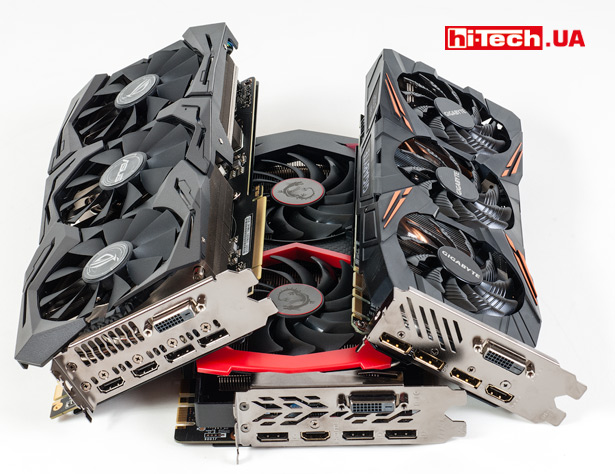
Like other Pascal graphics cards, models based on the GTX 1070 Ti have an excellent performance-to-power ratio. According to this indicator, NVIDIA solutions in recent years have been noticeably superior to competitors based on AMD GPUs.
An interesting situation: according to NVIDIA, the power consumption of the GTX 1070 Ti should be higher than the GTX 1070 and at the level of the GTX 1080. But according to our measurements, the GTX 1070 Ti and GTX 1070 video cards are almost at the same level in this indicator, but the power consumption of the GTX 1080 turned out to be higher .
The cost of GTX 1070 Ti video cards in our market is almost one and a half times higher than the recommended prices of NVIDIA. This is partly due to the novelty – the models are just appearing on sale. But this is also influenced by pricing features (our video cards are traditionally more expensive compared, for example, to the US market), as well as additional demand caused by the popularization of mining with video cards.
With the release of the GTX 1070 Ti, there were no big changes in the video card market. NVIDIA simply filled a small niche between its own video cards.
At the same time, the user has an additional opportunity to more precisely select a video card according to his budget in the class of high-end video cards.
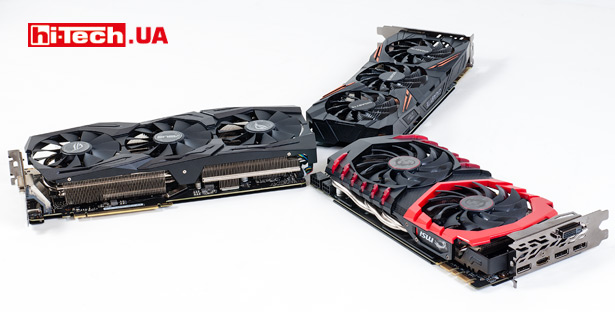
Read also:
- Test of the Sapphire Pulse Radeon RX 580 video card. Easy upgrade of Polaris
- Test of the MSI GeForce GTX 1080 TI Gaming X 11G video card. Proudly leading the 1080 Ti
- Where did the video cards go? They were bought up by miners…
- Review of the ASUS ROG STRIX-GTX1060-O6G-GAMING video card. The most pumped up GTX 1060
- Review of video cards based on NVIDIA GeForce GTX 1060 from Inno3D, MSI and Zotac. Chic middle class
- Review of the Asus EX-GTX1050-2G video card. The youngest Pascal
- Testing the AMD Radeon RX 460. Budget video cards become faster
- NVIDIA GeForce GTX 1080 and others. Test of mid- and high-end video cards
Engineer of the Test Laboratory
Don't miss interesting news
Subscribe to our channels and read announcements of high-tech news, tes
Oppo A6 Pro smartphone review: ambitious

Creating new mid-range smartphones is no easy task. Manufacturers have to balance performance, camera capabilities, displays, and the overall cost impact of each component. How the new Oppo A6 Pro balances these factors is discussed in our review.
Editor’s Choice 2025. Best devices of the year by hi-tech.ua

The best gaming laptops, mice for work, gaming keyboards, smartphones, and wireless headphones of 2025. Among them, we will highlight the most interesting ones and those that we can recommend buying.
BYD showed ultra-fast charging for electric cars: 400 km in 5 minutes charger development electric transport
BYD is one step closer to its goal of making electric vehicle charging comparable in speed to refueling vehicles with an internal combustion engine
Best games of 2025 according to Steam games rating Steam
During 2025, almost 20 thousand new games were released on Steam – at the time of preparation of the material, their number reached 19,705.



